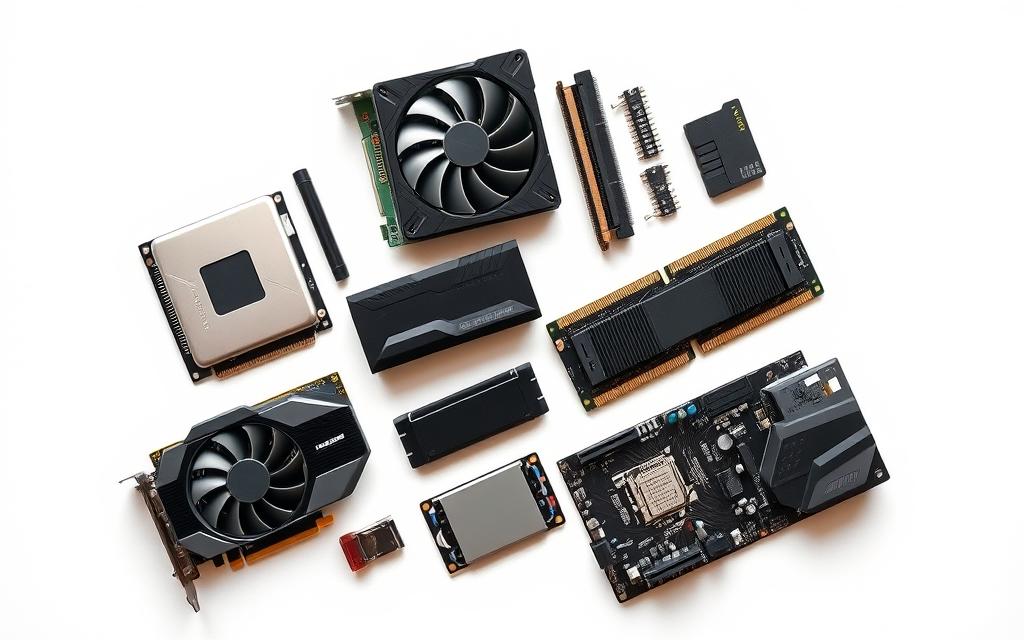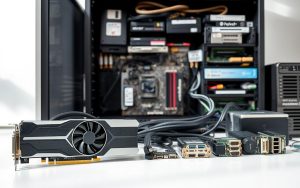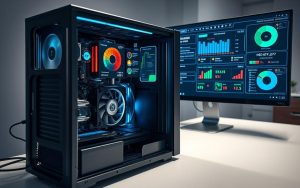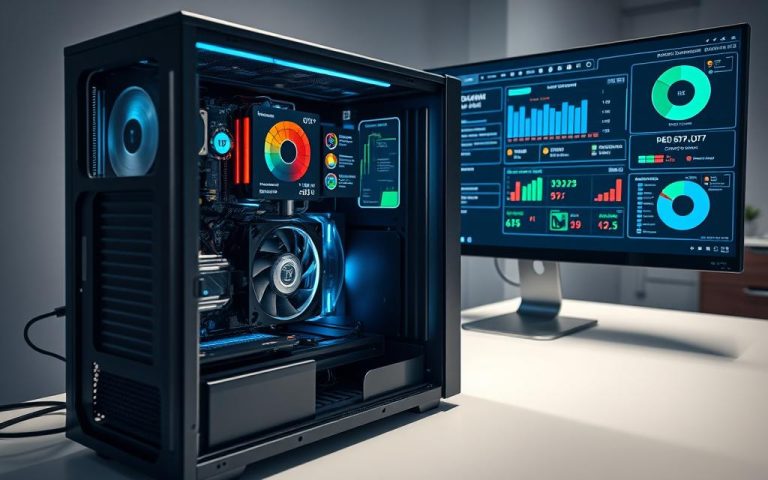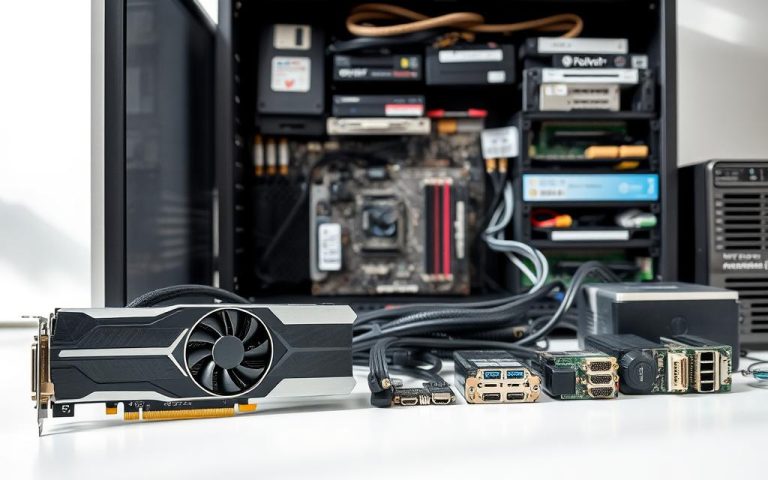Computer Hardware Parts: A Complete Guide to Key Components
Computer hardware forms the physical core of modern computing. These vital PC parts power everything from basic tasks to complex applications1.
Grasping computer hardware is key for tech enthusiasts. Modern systems blend intricate parts that work together smoothly2.
Hardware components define a computer’s performance and abilities. The tech world keeps advancing at a rapid pace.
Computing systems have evolved from bulky machines to slim, powerful devices. PC parts now offer great efficiency in various sizes2.
Choosing the right hardware needs careful thought. Processing power, storage, and compatibility are crucial factors.
Each component, from motherboards to graphics cards, adds to system performance1. This guide will explore the world of computer hardware.
We’ll help you understand the roles of essential PC parts. Knowing hardware basics is vital for making smart computing choices.
What are the hardware parts of a computer?
Computer hardware is vital for tech enthusiasts. These machines consist of various parts that work together to process information. They perform tasks across multiple hardware categories.
Modern computers have several critical hardware parts. These essential components fall into distinct categories serving specific purposes3.
Essential Components Overview
Internal hardware components are key to a computer’s operation. These include:
- Motherboard
- Central Processing Unit (CPU)
- Random Access Memory (RAM)
- Storage devices
- Graphics Processing Unit (GPU)
- Network Interface Card (NIC)
Primary Hardware Categories
Computer hardware falls into several key categories based on function:
- Processing Components: CPU and GPU, responsible for computational tasks
- Memory Systems: RAM and storage devices for data retention
- Input/Output Interfaces: Devices enabling user interaction
Understanding Component Roles
Each hardware part plays a unique role in system performance. The CPU, operating at 1-5 GHz4, acts as the computer’s brain.
RAM provides volatile memory, usually 4GB to 32GB3. Storage devices like SSDs offer reliable data preservation5.
External hardware like keyboards, mice, and USB drives complement internal systems. Together, they create a comprehensive computing ecosystem3.
The Central Processing Unit (CPU): The Brain of Your Computer
The Central Processing Unit is the core of any computer system. It’s the main computational engine that drives digital performance. Modern processors have greatly evolved, changing how we use digital devices.

CPUs process complex instructions at incredible speeds. Multi-core processors have transformed computing capabilities. They allow machines to handle multiple tasks at once6.
Modern processors manage numerous threads with remarkable efficiency. They can execute intricate computational processes quickly6.
CPU Architecture and Design
Modern CPU designs include advanced elements that boost processing power. These features enhance overall performance.
- Multiple processing cores for improved performance
- Advanced cache memory systems
- High-speed instruction processing
- Energy-efficient design
Clock Speed and Performance Metrics
Clock speed is the processor’s operational frequency. It determines how quickly a CPU can execute instructions. Modern processors like the Intel Core i7-8700 can reach 4.6 GHz6.
Multi-core processors greatly improve computational performance. They enable parallel processing, handling multiple tasks simultaneously6.
Modern CPU Features and Technologies
Today’s processors use advanced tech like hyperthreading. This allows a single core to manage multiple computational threads6. Cache memory is crucial for CPU performance.
Modern processors have cache sizes from 1 MB to 32 MB6. The semiconductor industry keeps pushing boundaries in processor innovation.
Intel has led processor innovation since 19757. Ongoing development of efficient, powerful CPUs promises exciting advances in computing technology.
Motherboard: The System’s Foundation
The motherboard is the heart of any computer system. It connects and coordinates essential hardware components. Modern motherboards have come a long way since the early days of personal computers.
Today’s motherboards are sophisticated technological platforms. They enable seamless communication between various computer elements. These circuit boards have evolved from simple designs to complex systems.
Motherboard form factors determine the board’s size and configuration. Asus, the global leader in motherboard production, offers multiple designs. These designs cater to different computing needs8.
The main form factors include:
- ATX (Standard size: 305mm x 244mm)
- Micro-ATX (244mm x 244mm)8
- Mini-ITX (170mm x 170mm)8
- Mini-STX (147mm x 140mm)8
The chipset is crucial for motherboard functionality. It manages communication between hardware components. Motherboards typically have northbridge and southbridge chipsets for different tasks8.
Key motherboard features include BIOS or UEFI firmware. These initialise hardware and load the operating system during startup9. Most motherboards offer expansion slots, RAM slots, and various connectivity options.
Choose a motherboard that’s compatible with your CPU. Consider memory requirements and future upgrade potential. The right motherboard ensures optimal system performance for your computing needs.
Memory and Storage Solutions
Computer memory and storage are vital for system performance and data management. RAM, SSDs, and HDDs have unique differences. Understanding these can help users choose the right computing solutions10.
RAM acts as the computer’s short-term memory. It enables quick data access and efficient multitasking. Modern RAM, like DDR5, offers better performance and stability than older versions10.
RAM Types and Specifications
- DDR4 memory: Widely used in current systems
- DDR5 memory: Provides enhanced performance and efficiency10
- RAM sizes typically range from 1GB to 64GB11
Storage Device Options
Storage solutions have greatly improved over time. SSDs have transformed data access speeds. They offer significant benefits over traditional HDDs:
- Faster read and write speeds (approximately 10 times quicker than HDDs)11
- Enhanced durability and reliability10
- SSD capacities ranging from 150GB to several terabytes11
Optimising Memory Performance
Memory optimisation involves choosing suitable RAM and storage technologies. NVMe SSDs can boost overall PC performance in various devices10. Upgrading RAM improves system responsiveness, especially for demanding tasks like video editing and gaming10.
Selecting the right memory configuration is crucial for maximising computing efficiency.
Understanding these solutions helps users create efficient computing environments. They can tailor their setups to meet specific needs and preferences.
Graphics Processing Units (GPUs) and Display Technology
GPUs are vital in modern computing, powering advanced visual experiences across various applications12. These specialised processors efficiently handle complex graphical computations13. They excel in parallel processing, enabling multiple calculations simultaneously.
Graphics cards have evolved remarkably since the early NEC μPD7220, which supported 1024×1024 resolution14. Modern GPUs now offer incredibly detailed rendering capabilities12. This technological leap has transformed visual computing.
- Integrated GPUs are embedded within the CPU, offering basic graphics capabilities
- Dedicated graphics cards provide superior performance for demanding tasks
- Professional-grade GPUs support advanced rendering and computational workloads
GPUs are crucial for high-resolution gaming and video editing. They also power scientific computing and artificial intelligence applications.
- High-resolution gaming
- Video editing
- Scientific computing
- Artificial intelligence applications
Display connectors have progressed alongside GPUs. HDMI, DisplayPort, and USB-C now offer sophisticated video transmission capabilities14.
| GPU Type | Performance | Typical Use Case |
|---|---|---|
| Integrated GPU | Basic | Everyday computing |
| Mid-range Dedicated GPU | Moderate | Gaming and content creation |
| High-end GPU | Exceptional | Professional rendering and advanced computing |
Video memory (VRAM) is crucial for graphics performance. Dedicated graphics cards typically offer more memory for complex visual tasks12.
Power Supply and Cooling Systems
Computer hardware needs top-notch power supply and cooling solutions. These systems keep computers running smoothly and extend their life. Good heat and power management is crucial for all users.
Power Supply Unit Fundamentals
Power Supply Units (PSUs) convert electricity for computer systems. Modern PSUs have different efficiency ratings that affect energy use15. The 80 Plus certification shows power efficiency, from Bronze to Platinum levels.
- Bronze level: Basic efficiency
- Silver level: Improved energy performance
- Gold level: High-efficiency standard
- Platinum level: Premium power management
Thermal Management Strategies
Good heat management stops performance issues and helps parts last longer16. Most computers use a mix of cooling methods. These include smart fan placement and heat-spreading techniques16.
| Cooling Method | Efficiency | Cost |
|---|---|---|
| Air Cooling | Moderate | Low |
| Liquid Cooling | High | High |
Efficiency and Performance Considerations
A typical power supply can work for 5-10 years, based on use and quality15. Gaming systems usually need 500W to 850W power supplies. This allows for future upgrades15.
Choosing the right PSU and cooling system is vital. It ensures system stability, energy efficiency, and long-term reliability.
Conclusion
Understanding computer hardware opens doors to the world of technology. Building a PC allows for personalisation and requires careful hardware compatibility17. Desktop computers remain popular for businesses, with multicore processors delivering top-notch performance17.
Optimising your system starts with choosing compatible parts. Experts suggest at least 4 GB RAM, but 8 GB is better for demanding tasks17. SSDs offer incredible speed boosts, outpacing traditional hard drives by five to eight times17.
The complexity of computer hardware requires careful selection and understanding. Successful PC building needs planning and technical know-how. Upgrading RAM is one of the best ways to boost performance18.
For gamers, designers, and professionals, grasping hardware interactions is crucial. It enables you to create a tailored computing experience that suits your needs18. By mastering computer hardware, you can confidently build and optimise your digital setup.
FAQ
What are the main hardware components in a computer?
How do I choose the right CPU for my needs?
What’s the difference between HDD and SSD storage?
How much RAM do I need for my computer?
What should I consider when selecting a motherboard?
How do I determine the right power supply for my system?
What’s the difference between integrated and dedicated GPUs?
How important is computer cooling?
Can I build my own computer?
How often should I upgrade my computer hardware?
Source Links
- https://www.hp.com/my-en/shop/tech-takes/post/most-important-computer-components
- https://www.corsair.com/us/en/explorer/diy-builder/blogs/the-anatomy-of-a-pc/?srsltid=AfmBOorOg3Eg15MjupWa-1tkehrE9ISw75xJlO-UjNRMF621zdO57stm
- https://www.techtarget.com/searchnetworking/definition/hardware
- https://en.wikipedia.org/wiki/Computer_hardware
- https://uk.crucial.com/articles/pc-builders/what-is-computer-hardware
- https://www.redhat.com/en/blog/cpu-components-functionality
- https://www.ibm.com/think/topics/central-processing-unit
- https://www.spiceworks.com/tech/hardware/articles/what-is-motherboard/
- https://www.techradar.com/computing/motherboards/what-is-a-motherboard
- https://www.kingston.com/unitedkingdom/en/blog/pc-performance/difference-between-memory-storage
- https://www.geeksforgeeks.org/what-is-a-storage-device-definition-types-examples/
- https://www.lenovo.com/gb/en/glossary/what-is-gpu/?srsltid=AfmBOopRjqGJci9KV3WmCZDg6-SCxwoX9qhVpN5g6uLJYWMlwC9JAUBq
- https://www.techtarget.com/searchvirtualdesktop/definition/GPU-graphics-processing-unit
- https://en.wikipedia.org/wiki/Graphics_processing_unit
- https://techhowtohub.com/explainers/a-guide-to-computer-hardware-components-and-their-functions/
- https://medium.com/computing-technology-with-it-fundamentals/system-hardware-component-cooling-system-in-a-computer-7d8602523c4a
- https://www.nibusinessinfo.co.uk/content/computer-hardware-components-and-specifications
- https://www.crucial.com/articles/pc-builders/what-is-computer-hardware

